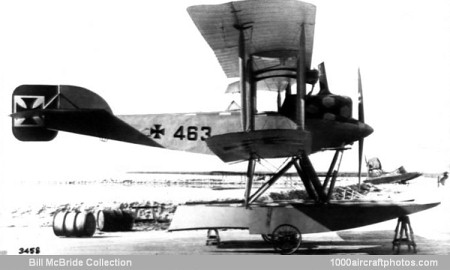08/31/2011. In addition to license production and repair of foreign products, the Kaiserliche Werften (Imperial shipyards) at Gdansk, Kiel and Wilhelmshaven were involved with the development and design of their own seaplanes during WW I. These types were only produced in small quantities and with the exception of the W 9 and W 10 built in Wilhelmshaven, they had no model designation.
Without exception, these were all single-engined twin-float biplanes, however, only little documentation has survived. In particular, the following versions emerged for the Fliegerkräfte (flying service) of the Kaiserliche Marine (Imperial Navy) of Germany (Seeflugzeug = seaplane; Schulung = training; Jagd = pursuit; Aufklärung = reconnaissance):
Wilhelmshaven:
Seeflugzeug (Schulung), Daimler DI engine (3 aircraft, s/n 401 to 403)
Seeflugzeug (Jagd) W 9, Benz Bz III engine (1 aircraft, s/n 945)
Seeflugzeug (Schulung) W 10, Benz Bz III engine (2 aircraft, s/n 461, 462)
Seeflugzeug (Aufklärung), Daimler D IV engine (1 aircraft, s/n 947)
Gdansk-Puck:
Seeflugzeug (Schulung), Daimler DI engine (2 aircraft, s/n 404, 405)
Seeflugzeug (Schulung), Benz Bz III engine (4 aircraft, s/n 467 to 470)
Seeflugzeug (Schulung), Benz Bz III engine (2 aircraft, s/n 1105, 1106)
Seeflugzeug (Aufklärung), Daimler D IV engine (1 aircraft, s/n 1650)
Kiel:
Seeflugzeug (Schulung), Benz Bz III engine (4 aircraft, s/n 463 to 466)
The Seeflugzeug (Schulung) produced at Kiel was a conventional two-bay unstaggered equal span biplane of wooden construction covered with fabric and seated pilot and instructor in open tandem cockpits. Power plant was an 150 hp Benz Bz III six-cylinder, liquid-cooled, in-line engine, fitted with a stack exhaust pipe extending above the top wing. Four aircraft were ordered in October 1915, the first was flown in the summer of 1916, and subsequently delivered to the Seeflugzeug-Versuchskommando (seaplane testing command) at Warnemünde.
